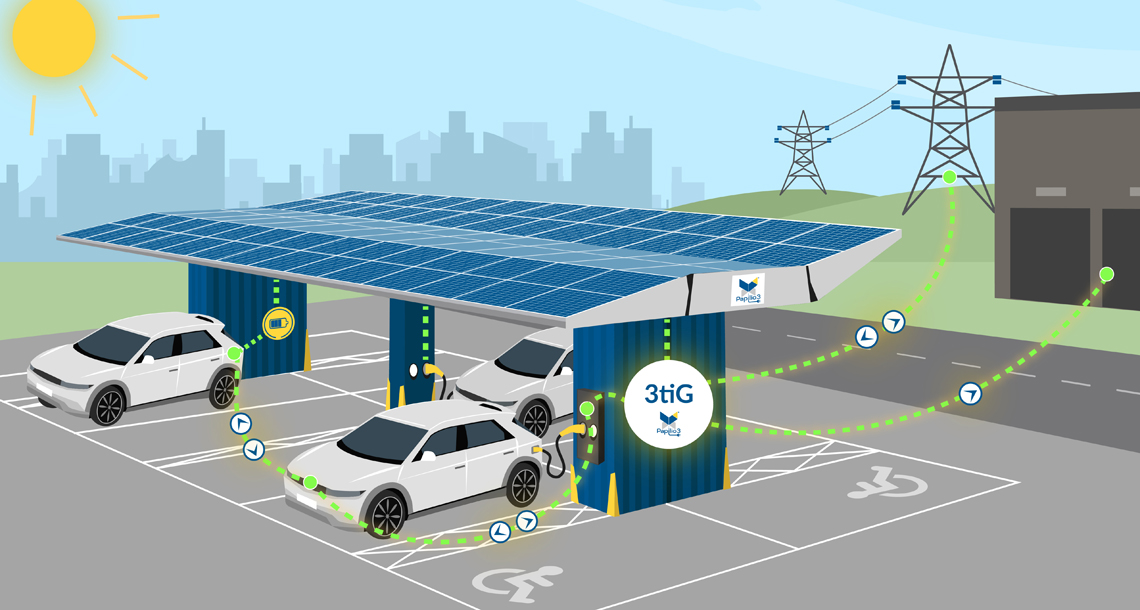UK government funds EV-to-grid project
- January 17, 2024
- Steve Rogerson

A consortium of British companies has secured £1.3m in government funding to explore how electricity stored in electric vehicle (EV) batteries can be used to smooth out peaks in supply and demand on the electricity grid.
3ti, a UK’s designer, installer, funder and operator of solar car parks (SCPs), is leading the project funded by the Department for Energy Security & Net Zero, and delivered by Innovate UK.
The project is setting out to integrate bi-directional DC charging and the associated power management systems into Papilio3, a pop-up solar car park and EV charging hub. The V2X FastHub project could be a watershed moment for future energy security, providing a clear pathway to help resolve the issue of intermittent supply from renewables by using EV batteries as grid assets.
The consortium brings together renewable energy expert 3ti with EV power product provider Turbo Power Systems (TPS), smart energy company GridBeyond, and EV and decarbonisation expert Cenex, in a 17-month collaboration to deliver a system that includes a six-month real-world demonstration.
3ti (3ti.co.uk) will lead the project, delivering a customised Papilio3 with smart grid controls and a 280kWh DC battery. TPS will harness its DC microgrid systems, managing the bi-directional charging technology through CCS and Chademo EV charge points, while GridBeyond will oversee energy management and aggregation services through its flexible energy management system (EMS). Cenex will host the vehicle trial, which will include the procurement of the trial vehicle fleet, data capture, analysis and final report to Innovate UK.
Adapted as a V2X FastHub unit for the project, 3ti’s Papilio3 is a smart grid in-a-box that can host up to 12 EVs at a time, housed within an upcycled, rapidly deployable shipping container that can be placed almost anywhere. With a solar canopy and energy storage battery, the system has already delivered in applications for factories, hospitals, leisure centres and council buildings across the UK. For this application, Papilio3 will implement a DC microgrid system, integrating three times faster, bi-directional DC EV charge points with a 280kWh integral battery storage system and 20kWp solar roof array.
Through a charge-as-a-service business rental model, the unit simplifies installation and reduces up-front costs or the need for long-term commitment. The result is commercially attractive, replicable and scalable EV charging for a multitude of organisations, including medium dwell-time workplaces, destinations, return-to-base fleets and delivery depots.
The provision of EV charging at amenity and business locations increases revenue generation and enables the faster roll-out of EV charging while simultaneously reducing the burden on carbon-intense rapid charging infrastructure.
“Everybody wants more EVs on the grid,” said Mark Potter, CTO at 3ti. “They represent a massive scale, distributed energy resource that can be used to balance real-time supply and demand. This project will prove that bi-directional EV charging can work in the real world. Connected EVs will be teamed together to act as virtual power and energy storage facilities, with each car releasing and replenishing its stored energy according to user preferences and grid demand. This generates income and cost savings, which can be passed on to our customers.”
Smart microgrids support a more sustainable and reliable energy transition, helping the UK meet its net-zero and energy security targets. This project will be the first in the world to trial a 12-charge-point DC smart microgrid for CCS V2X based on ISO15118-20, published in 2022. Each charge point will also support Chademo for compatibility with existing vehicles. This set-up should provide faster, bi-directional EV charging at speeds up to ±30kW, with much higher power and round-trip energy efficiency than AC.
“Being able to recharge at 30kW is critical to success in this market,” said Potter. “In destination charging, most EVs will only charge at 7 or 11kW using AC, even if the charge point is rated at 22kW. Being able to charge at 30kW regardless of vehicle limitations makes more energy available for V2X export without impacting the overall net charge. With DC microgrid V2X, meaningful energy and power levels can make it worthwhile to the asset owners, also offering up to 95% round-trip efficiency, compared with typically 60 to 70% in the AC domain. The key to unlocking V2X value is having lower opex and capex, and this project will deliver both.”
Matthew Knight, principal technical specialist at Cenex (www.cenex.co.uk), added: “With almost a decade of experience in developing V2X technology, Cenex is excited to bring a novel concept to life in this space. We’re creating a pre-fabricated hub that integrates renewable generation, energy storage and the latest bidirectional EV charging technology to maximise energy use and value while reducing emissions. In this project, our role as a research and technology organisation involves running a technology demonstration, focus group workshops, trial data collection, technical analysis and business case modelling.”
And Micheal Phelan, CEO at GridBeyond (gridbeyond.com), said: “GridBeyond is delighted to be participating in this innovative, ground-breaking project which will help demonstrate the potential of vehicle-to-grid technology and how it can help support a low carbon grid of the future. We are excited to be working alongside key stakeholders and partners to bring all our expertise together for future market insight.”
Nigel Jakeman, engineering and business development director at Turbo Power Systems (www.turbopowersystems.com), said: “It’s both gratifying and exciting to see the world first advanced EV charging technology we have developed on the back of our 40 plus years at the forefront of power solutions, being used within a partnership of true innovators to create a system which will play a pivotal role in decarbonisation and solving climate change, one of the biggest threats our planet faces today.”
The V2X innovation programme is part of the up to £65m Flexibility Innovation Programme, funded from the £1bn Net Zero Innovation Portfolio.




